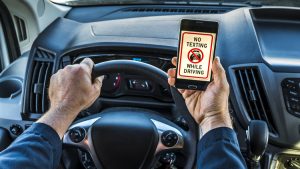Other Safety – Driving Safety

What is Distracted Driving?
Distracted driving is any activity that diverts attention from driving, including talking or texting on your phone, eating and drinking, talking to people in your vehicle, fiddling with the stereo, entertainment, or navigation system—anything that takes your attention away from the task of safe driving.
Texting is the most alarming distraction. Sending or reading a text takes your eyes off the road for 5 seconds. At 55 mph, that’s like driving the length of an entire football field with your eyes closed.
You cannot drive safely unless the task of driving has your full attention. Any non-driving activity you engage in is a potential distraction and increases your risk of crashing.
Take the pledge
The fight to end distracted driving starts with you. Commit to driving phone-free today.
- Protect lives by never texting or talking on the phone while driving.
- Be a good passenger and speak out if the driver in my car is distracted.
- Encourage my friends and family to drive phone-free.
One Text Or Call Could Wreck It All
Texting is one of the most dangerous forms of distracted driving. At any given moment across America, approximately 660,000 drivers are using or manipulating electronic devices while driving, a number that has held steady since 2010. Distracted driving has become a deadly epidemic on America’s roadways. 3,154 people were killed in 2013, and an estimated 424,000 were injured in motor vehicle crashes that involved distracted drivers. Our youngest and most inexperienced drivers are most at risk, with 10% of all distracted driving crashes involving drivers under the age of 20.
ANTI-DISTRACTED DRIVING ENFORCEMENT CAMPAIGN
Put Your Phone Away or Get Ready to Pay
U Drive. U Text. U Pay.
Distracted driving has become a national epidemic—endangering passengers, adjacent vehicle occupants, motorcyclists and bicyclists, and nearby pedestrians. While we generally think of distracted driving like texting or talking on the cell phone, it can take many other forms: adjusting the radio station, applying makeup, eating, chatting with other passengers, or taking a sip of your drink can all distract a driver from the essential task of safe driving. Texting has become one of the most common, pervasive forms of distracted driving, and too many drivers succumb to this deadly—and often, illegal—habit.
The Frightening Stats
- Between 2012-2017, nearly 20,000 people died in crashes involving a distracted driver.
- According to NHTSA, there were 3,166 people killed in motor vehicle crashes involving distracted drivers in 2017. While this reflects a 9 percent decrease from 2016 to 2017, there is still much work to be done. In the last six years, 9.5 percent of all fatal crashes involved a distracted driver.
- Texting while driving has become an especially problematic trend among younger drivers. In fact, in 2017, 8 percent of people killed in teen (15-19) driving crashes died when the teen drivers were distracted at the times of the crashes.
- According to NHTSA, young drivers 16- to 24-years-old have been observed using handheld electronic devices while driving at higher rates than older drivers since 2007.
- Female drivers with a cell phone have been more likely to be involved in fatal distracted driving crashes than male drivers every year since 2012.
Safety Tips for Driving
- If you are expecting a text message or need to send one, pull over and park your car in a safe location. Once you are safely off the road and parked, it is safe to text.
- Designate your passenger as your “designated texter.” Allow them access to your phone to respond to calls or messages.
- Do not engage in social media scrolling or messaging while driving. Cell phone use can be habit-forming. Struggling to not text and drive? Put the cell phone in the trunk, glove box, or back seat of the vehicle until you arrive at your destination.
Put Your Phone Away or Get Ready to Pay
- When you get behind the wheel, be an example to your family and friends by putting your phone away. Texting while driving isn’t trendy “normal” behavior—it’s a selfish, deadly, and, oftentimes, illegal activity that could kill you, a loved one, a friend, or a stranger.
- In 47 States, the District of Columbia, Puerto Rico, Guam, and the U.S. Virgin Islands, texting while driving is an illegal, ticketable offense. You could end up paying a hefty fine and could get points on your license.
- If you see something, say something. If your friends text while driving, tell them to stop. Listen to your passengers: If they catch you texting while driving and tell you to put your phone away, put it down.
- Remember, when you get behind the wheel, put your phone away. U Drive. U Text. U Pay.
For more information, visit www.trafficsafetymarketing.gov.
Learn more about Distracted Driving in Fatal Crashes 2017.
#justdrive




